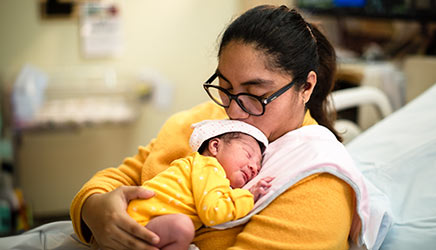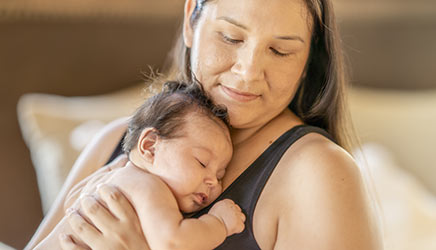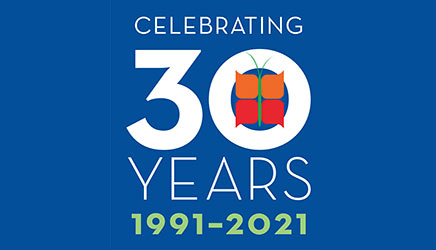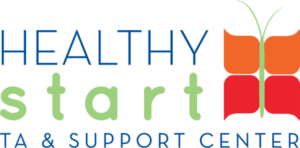What is Healthy Start?
The Health Resources and Services Administration (HRSA)’s Division of Healthy Start and Perinatal Services leads and guides national efforts to improve the health outcomes of mothers and women, through several initiatives. Since 1991, the Healthy Start Initiative: Eliminating Disparities in Perinatal Health (Healthy Start) Program has aimed to improve health outcomes before, during, and after pregnancy and reduce the well-documented racial/ethnic disparities in maternal and infant health outcomes. Healthy Start serves women, infants, fathers, and families throughout the maternal child health continuum of care (from preconception through 18 months postpartum), in communities with the highest rates of adverse infant and maternal outcomes.
In recent years, HRSA launched two related, special initiatives. Since 2022, the Catalyst for Infant Health Equity Program has aimed to:
- Continue reducing overall infant mortality rates in the US, and
- Decrease and ultimately eliminate disparities in infant mortality across racial/ethnic groups by achieving steeper declines for groups with the highest rates.
Since 2023, the Healthy Start Initiative – Enhanced (HSE) Program has aimed to support projects in diverse communities and populations (e.g., rural, urban, non-Hispanic Black, American Indian/Alaskan Native [AI/AN]) experiencing the greatest disparities in maternal and infant health outcomes.
A Brief History of Healthy Start

President George H. W. Bush creates the interagency White House Task Force to Reduce Infant Mortality. Healthy Start is one of 18 proposals submitted to the White House Task Force.

The Secretary’s Advisory Committee on Infant Mortality (SACIM) – now called the Advisory Committee on Infant and Maternal Mortality (ACIMM) – is formed. ACIMM advises the Secretary on Department of Health and Human Services’ (HHS) programs that are directed at reducing infant and maternal mortality and improving the health status of pregnant women and infants.

7 sites are added to the Phase I Healthy Start Initiative as “special projects” and funded by the March of Dimes, bringing the total of demonstration projects to 22.

As part of the Replication Phase of Healthy Start, additional sites are added to reproduce the model of the original 15 programs by conducting outreach, case management, and health education.

HRSA’s MCHB DHSPS launches the Healthy Start program as a presidential initiative. Healthy Start aims to reduce infant mortality by 50% in 5 years. 15 sites with infant mortality rates 1.5 to 2.5 times the national average are selected as demonstration projects. The sites are funded to be innovative, community-based, community-driven projects tasked with reducing infant mortality and improving the health and well-being of women, infants, and their families. A hallmark of Healthy Start, which continues today, is the requirement of a Community Consortium (previously called Community Action Network) where community voices are lifted.

The National Healthy Start Association (NHSA) is established by several Project Directors from the original 15 Healthy Start sites. The membership organization focuses on advocacy and its efforts led to Healthy Start’s first federal authorization.

Healthy Start is authorized by Congress as part of the Children’s Health Act.

New Healthy Start Funding Cycle
Healthy Start expands its scope beyond providing comprehensive health services to focus on 1) supporting child development from conception to age 2 years; 2) screening for maternal depression; 3) promoting father involvement; and 4) uplifting consumer voices.

New Healthy Start Funding Cycle

Healthy Start Reauthorization Act is enacted.

New Healthy Start Funding Cycle
There are now 105 Healthy Start sites located in 39 states, Puerto Rico, and the District of Columbia.

ACIMM issues recommendations and a framework for a national strategy to reduce infant mortality. This reaffirms the need for continued federal investment in Healthy Start and similar programs (e.g., Title V MCH Services Block Grant, MIECHV Program, WIC).

New Healthy Start Funding Cycle
Healthy Start establishes five programmatic approaches: improve women’s health; promote quality services; strengthen family resilience; achieve Collective Impact; increase accountability through quality improvement, performance monitoring and evaluation.

Healthy Start celebrates its 25th anniversary.

New Healthy Start Funding Cycle
The 101 funded projects represent rural, urban, tribal, and border communities in 37 states, the District of Columbia, and Puerto Rico. Healthy Start refines its programmatic approaches to focus on 1) improving women’s health; 2) improving family health and wellness; 3) promoting systems change; and 4) assuring impact and effectiveness through workforce development, data collection, quality improvement, performance monitoring, and evaluation.

Healthy Start Reauthorization Act is enacted.

Healthy Start celebrates its 30th anniversary.

DHSPS establishes the Catalyst for Infant Health Equity (Catalyst) Program, which supports the implementation of existing action plans that apply data-driven policy and innovative systems strategies to reduce infant mortality disparities in a specific county/jurisdiction. 9 grantees are awarded in total, including 5 existing HS grantees.

DHSPS establishes the Healthy Start Initiative – Enhanced (HSE) Program. HSE puts an increased emphasis on addressing social determinants of health in order to improve disparities in maternal and infant health outcomes. Recipients have increased flexibility to customize interventions to meet the unique needs of their target population. 10 grantees were awarded in total, including 4 existing HS grantees.

New Healthy Start Funding Cycle
105 Healthy Start projects are funded! HS has two focus areas: 1) providing direct and enabling services (e.g., screening and referrals, case management and care coordination, health and parenting education, linkage to clinical care) to enrolled HS participants; and 2) convening Community Consortia (formerly known as Community Action Networks) comprised of diverse, multi-sector partners to advise and inform HS activities as well as to develop and implement plans to improve perinatal outcomes within the selected project area.
"Healthy Start Is..."
This five-minute video features Healthy Start project directors from around the country describing the essence of the healthy Start program by finishing the sentence “Healthy Start is…”. Grantees can use this video to introduce Healthy Start to community partners, show it at community meetings, or post it on their websites.
